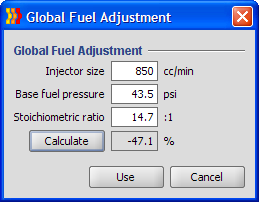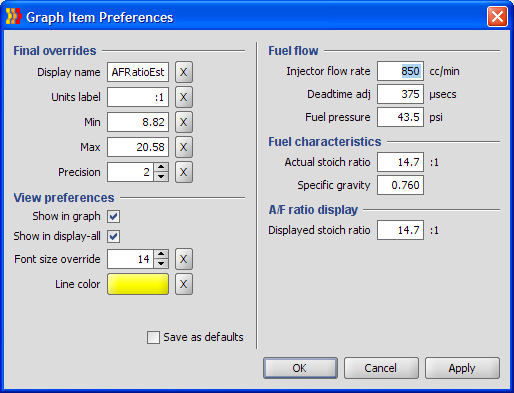Table of Contents
ECMLink 101 - Initial checks
On this page, we're going to assume you've already run through the install procedure and have gotten a good connection established with the ECU. If you have not, please review the Installation page first.
Verify
Base MAF type
In the ECU Config → MAF Comp tab, check your Base MAF type. This should say something like “Stock”, “3G/EVO8”, “GM 3in”, etc. You want to make sure this matches what you actually have installed on the car. If you have a GM MAF Translator device made by Full Throttle (as opposed to running the GM MAF directly into the ECU using our cable), then you'll want to select “Stock” because the translator is supposed to provide a signal to the ECU that more or less simulates a stock Mitsubishi airflow sensor.
Global fuel
Go to the ECU Config → Fuel tab and check the global fuel adjustment slider. This one is a bit more complicated to explain simply because there are a lot of things you can do to your car's setup that will affect this value. These things include:
- Changing injector size (of course)
- Changing base fuel pressure
- Changing fuel type (gasoline, E85, etc.)
To help with this, there is a “calculate” button on the Fuel tab near the Global fuel adjustment area. Click this Calculate button and enter appropriate values for your specific setup. The following screenshot shows a “typical” FIC 850 configuration on gasoline with a 2G ECU.
1G ECU will default to a different base fuel value (37psi). Adjust this only if you've installed an aftermarket fuel pressure regulator or you know your car is running some different pressure than the default.
There are a number of pages available to provide more help in this area.
You're basically on this tab just to convince yourself that the global fuel adjustment value is appropriate for your configuration. This is VERY important. Do not gloss over this. The deadtime value isn't nearly as critical until you start trying to fine tune your fuel trims.
Configure
BoostEst
BoostEst estimates “boost” from airflow per rev. On a properly configured car, this value should match measured manifold pressure pretty closely at wide open throttle around 5500-6500 RPM. Outside this range, BoostEst is expected to fall off from measured. The BoostEst calculation is not calibrated to read accurately at any other engine speed (RPM).
That said, BoostEst is still VERY useful. It can be used to catch gross errors in configuration or it can be used to fine tune a setup that's running pretty well already.
But, you have to configure BoostEst for your situation. To do that, start a new data stream (F11 or ECU → Start stream) then just stop it (F11 again or hit the stop button in the toolbar). That should bring up the datalog tab for you. Add BoostEst to the displayed values using the Display Values dialog (F9 or Edit → Display values).
Once BoostEst is in the graph legend, double click it or right click on it and select BoostEst → BoostEst preferences. Enter your engine displacement (2.0L is the normal, stock value for our DSM motors) and your altitude then hit OK.
AFRatioEst
AFRatioEst provides an estimated A/F ratio based on reported airflow and commanded fuel (injector pulsewidth). This should NOT be used to performance tune your car. It should be used as a check that reported airflow and estimated fuel flow make sense. This display value depends on knowing a LOT about your setup. If you do not provide accurate information here, you will not get accurate results. Garbage in = garbage out.
Versions 3.19.139 and later
With the release of version 3.19.139 of our ECU firmware, we have dramatically changed how AFRatioEst is configured. If you have at least version 3.19.139 inside your ECU, you can ignore this entire section because the configuration of AFRatioEst is done for your automatically, inside the ECU. You can check to see which version is inside your ECU by reading the “Check your current firmware version” section of this page.
Versions prior to 3.19.139
Get AFRatioEst in your graph legend and then edit the display preferences (follow the same procedure as outlined above for BoostEst). You'll need to configure the preferences as exactly as possible. Provide information on injector size, your configured deadtime adjustment, and base fuel pressure. You also need to configure information about the fuel you're running. If you're running regular pump gas, then just leave the defaults of 14.7:1 for actual stoich ratio and 0.760 for specific gravity. The following shows a typical 2G setup configured for 850 injectors and pump gas.
If you're running a 1G manual transmission car with the stock fuel pressure regulator, then your fuel pressure will be 37psi. If you're running a 1G automatic transmission car with the stock automatic fuel pressure regulator, then you'll use 43.5psi.





